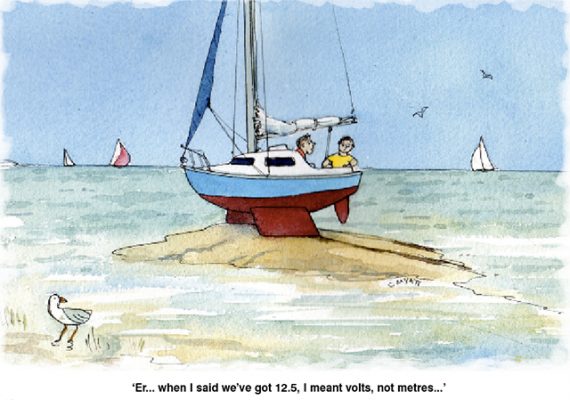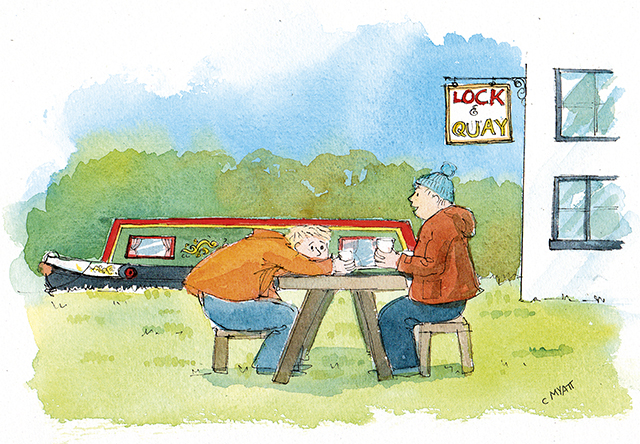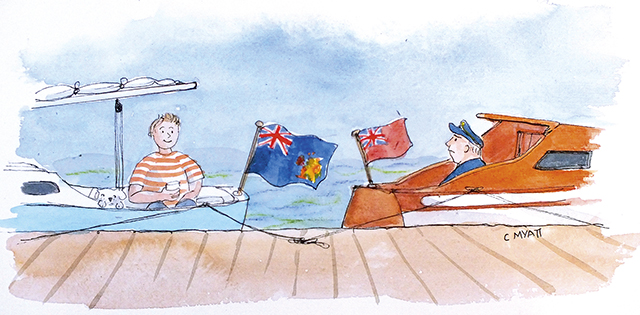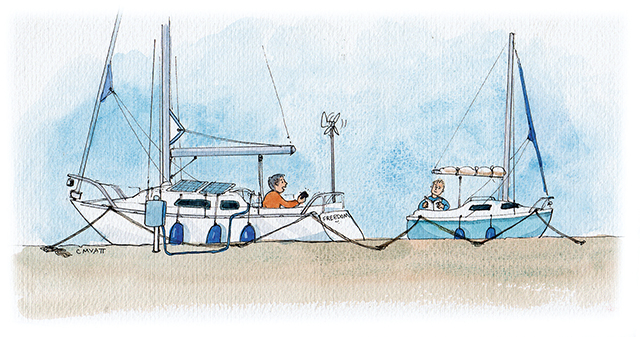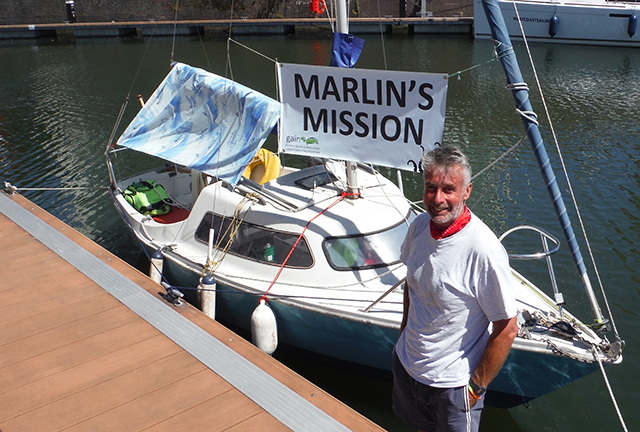Technological advances in onboard systems can inspire awe – or something else entirely
I could tell my classic-leaky-wooden-boat sailor chum Dan was impressed. In fact, I don’t think he’d ever seen anything quite like my Sailfish, writes Dave Selby.
As he tapped the hull in wonder at its complete lack of weeping knots, rusty nails and holes, I took his expression to be one of awe; or it could have been just ‘or!’, as I don’t think he’d ever seen a boat with water mainly on the outside.
But that was only the start of his enlightenment. To say I’ve embraced technology is quite an understatement. Over the last year my Sailfish has been festooned with more computing power than the first rocket that landed on the moon – and that’s just in my rather out-of-date Android phone that kids would be ashamed of; it’s a year old.
As I explained the complex onboard systems his eyes bulged in wonder… or something. For the first time, I’ve got GPS in the form of a handheld VHF that tells you where you are, and as it’s waterproof it even knows where it is if it falls overboard.
Of course, if that happens it’s only a matter of seconds before there’s considerable deviation between where it is and where you are, but that’s not a problem for a techno sailor like me as I’ve also got an action camera that not only knows where it is, but how fast you’re going and how many G you’re pulling: there were times in boisterous conditions when I was pulling something like 1G: in layman’s terms, that’s one times my bodyweight.
It’s an amazing bit of kit; or it was until it dropped overboard when I pressed the ‘on’ button off Limehouse Basin to capture some extreme action video of me pulling 1G as I wafted down the Thames.
Mind you, as it’s waterproof it still probably knows where it is, at least until the battery goes flat. But that’s not even a problem as I have nav software on my phone which knows where the action camera is: if you’re interested, I can give you the precise lat and long.
Not that I’ve become reliant on technology, but all this gear lets you get on with the real business of sailing – a fine balance between constantly monitoring your electricity reserves and telling everyone about it on social media.
As Dan and I left Brighton I explained that we were probably pulling 1G, that the solar panels were feeding the battery with 14.2V and that we were doing ‘3.1, no, 3.4, hang on, 3.6 knots over the ground’.
Dan had his ‘or’ expression again as he asked our heading: ‘We’re holding steady at 14.2V,’ I explained, as I interfaced live images of his ‘or’ face to my nav software for uploading to social media. Then I noticed the speed had dropped off to 3.5 knots over the ground and ticked Dan off for losing concentration. I had the evidence on my nav-phone-thing.
In answer to his earlier query I pointed out Littlehampton on the screen, showed him it was in a straight line, and indicated a vague arc ahead of the boat. Of course, it would be unseamanlike to rely purely on technology, so I told him to try not to hit the land as I jumped below to check the digital voltmeter which interfaces with my battery via a multi-point splitter with USB ports and lighter socket (£4.99 from Lidl).
Unlike the rest of my equipment, the digital voltmeter doesn’t know where it is, but that’s OK because I do; it’s always plugged into the splitter thing.
As I looked I noticed that we’d dropped off to 14.1V and explained that this was not an immediate concern, but reassured Dan that I’d keep monitoring it.
It was around then that he pulled his ‘or’ face again and asked if my nav-phone-thingy knew where the kettle was. Hardly subtle, but I did my best to make a cup of tea while monitoring the onboard systems and admonishing him for dropping off to 2.9 knots, even though the motorboats around seemed to be moving along briskly over glassy blue water.
Dan couldn’t get home from Littlehampton that night so he stayed over, and I was hoping for a little more commitment from him the next day vis-à-vis boat speed and attitude. I wasn’t expecting mutiny.
Something in him had changed, because he had a quite angry ‘or’ expression and instructed me to switch all the stuff off and get out the charts, dividers, plotter, tide tables and hand-bearing compass.
I said this was foolish as we’d be sailing blind, but went along with him. Truth be told, it was satisfying to take back bearings, line up transits, allow for leeway and tidal flow, draw lines on the chart and thread through the Looe Channel round Selsey Bill.
Plus, we made a better passage than if we’d zig-zagged to buoys marked as waypoints.
Better yet, as we got to Gosport I realised we’d set a record. We had 14.3V of leccy, a first. I hope that helps.
What to do when you run aground
Whether you go to sea under power or sail, you'll almost certainly find yourself aground at some point in your…
Nav in a Nutshell: Clearing bearings
In the first of his series on back-to-basics navigation Dick Everitt explains how to use a few simple lines to…
Nav in a Nutshell: What is a transit and how are they used in navigation
Lining up a pair of appropriate land features or navigation marks can help keep you safe, as Dick Everitt explains
Nav in a nutshell: Looks good on paper
Up-to-date printed paper charts are a good bet for identifying your position – but they do have their limits, says…
Nav in a nutshell: Electronic charts
Dick Everitt assesses the differences between raster and vector charts when deciding on which chart plotter to buy
The best kind of lock-in – Dave Selby’s Mad about the Boat column
PBO columnist Dave Selby shares a Lock and Bull story: a pub wasn’t a pub in olden times unless it…
Full bed and boards – Dave Selby’s Mad about the Boat
PBO columnist Dave Selby discusses the prospect of opening a boatel...
My supply of ensigns dried up – Dave Selby’s Mad about the Boat podcast
Dave provocatively contends that an ensign can make a serviceable tea towel – and vice versa
A racing uncertainty – Dave Selby’s Mad about the Boat
Not entirely sure if he has what it takes to become a competitive sailor, Dave issues a treatise on the…
Nav in a nutshell: Shaping a course
GPS is not infallible, so it makes sense to know the basics of shaping a rough ‘course to steer’ on…
A whacking great outlay – Dave Selby’s Mad about the Boat
The real cost of engineering solutions to a problem that didn’t exist in the first place, muses PBO columnist Dave…
Ohm improvements – Dave Selby’s Mad about the Boat
Formerly ohmless and happy, ‘analogue Dave’ is now going digital
Sailfish challenger Dave Selby reaches London on his ‘last legs’
PBO's Dave Selby, who is battling a rare nerve illness, won a tense race against time to sail his 18ft…
Nav in a nutshell: Lee bowing defined
Dick Everitt explains how you can get a little lift from the tide
Lessons learned after yacht sinks during grounding recovery
“We deserved to get away with a few scratches and a bit of embarrassment, not to get the boat sunk”…
Yacht runs aground 400 metres into first voyage
24-footer still stranded on Guernsey reef




